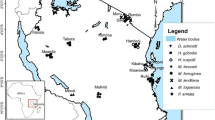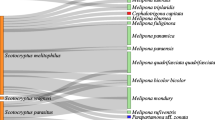Abstract
Mites have been observed on the bumblebee’s body and inside their nest for over 150 years, and parasitic relationships between them have occasionally been reported. One of the most interesting animal associations between mites and bees is phoresy. At present, no study has evaluated the distribution patterns of phoretic mites on bumblebees nor the factors that might be influencing such association. The main goal of this research was to determine whether an aggregation of external mites on bumblebees is influenced by (a) the phoretic mite load per bee, (b) the host species, (c) the caste of bumblebee, (d) the interaction between mite load and bee species, and (e) the presence of a suitable physical place for the mites to accommodate on the bee body. The following mite species were recorded on Bombus atratus and Bombus opifex: Kuzinia laevis, Kuzinia americana, Kuzinia affinis, Kuzinia sp., Pneumolaelaps longanalis, Pneumolaelaps longipilus, Scutacarus acarorum, and Tyrophagus putrescentiae. Our results indicate that Kuzinia mites have a strong preference for a particular region on the propodeum, which has shorter hairs than on most areas of the body. In addition, generalized linear model analysis demonstrated that mite aggregation was influenced by the caste and host species.

Similar content being viewed by others
References
Abrahamovich, A.H., Bischoff de Alzuet, A.D. (1989) Relaciones foréticas entre ácaros (Acaridae y Chaetodactylidae) e Himenópteros (Anthophoridae, Xylocopinae). Rev. Soc. Ent. Arg. 47(1-4)
Abrahamovich, A.H., Tellería, M.C., Díaz, N.B. (2001) Bombus species and their associated flora in Argentina. Bee World 82, 76–87
Abrahamovich, A.H., Díaz, N.B., Lucia, M. (2007) Identificación de las “abejas sociales” del género Bombus (Hymenoptera, Apidae) presentes en la Argentina: clave pictórica, diagnosis, distribución geográfica y asociaciones florales. Revista Fac. Agron. Univ. Nac. La Plata. 106, 165–176
Allen, G.R., Seeman, O.D., Schmid-Hempel, P., Buttermore, R.E. (2007) Low parasite loads accompany the invading population of the bumblebee. Bombus terrestris in Tasmania. Insectes Soc. 54, 56–63
Brandenburg, R., Kennedy, G. (1982) Intercrop relationships and spider mite dispersal in a corn/peanut agroecosystem. Entomol. Exp. et applic. 42, 269–276
Bush, A.O., Lafferty, K.D., Lotz, J.M., Shostak, A.W. (1997) Parasitology meets ecology on its own terms: Margolis et al. revisited. J. Parasitol 83(4), 575–583
Chmielewski, W. (1971) The mites (Acarina) found on bumble-bees (Bombus Latr.) and in their nests. Ekol. Pol. 19, 57–71
Chmielewski, W. (1977) Results of observations on associations of mites with insects (Acari - Insecta). Bull. Ent. Pol. 47, 59–78
Chmielewski, W. (1998) Mites (Acarina) occurring on social bees (Hymenoptera: Apidae: Apinae, Bombinae). Wiad. Entomol. 6, 201–206
Chmielewski, W., Baker, R. (2008) Mites (Acarina) phoretic on some common bumblebee species (Bombus spp.) from the Pulawy area (South-Eastern Poland). J. Apic. Sci. 52, 37–47
Donzé, G., Hermann, M., Bachofen, B., Guerin, M. (1996) Effect of mating frequency and brood cell infestation rate on the reproductive success of the honeybee parasite Varroa jacobsoni. Ecol. Entomol. 21, 17–26
Eickwort, G.C. (1994) Evolution and life-history patterns of mites associated with bees. In: Houck, M.A. (Ed.), Mites, Chapman and Hall, New York, pp. 218–251
Engel, M.S. (2000) Classification of the bee tribe Augochlorini (Hymenoptera: Halictidae). Bull. Am. Mus. Nat. Hist. 250, 1–89
Fain, A., Pauly, A. (2001) Notes on phoretic deutonymphs of mites (Acari) associated with Old World Megachilidae and Anthophoridae (Insecta, Hymenoptera), mainly from Madagascar 1. Families Chaetodactylidae, Acaridae, Histiostomatidae and Winterschmidtiidae (Astigmata). Belg. J. Entomol 3(1), 125–142
Fain, A., Engel, M.S., Flechtmann, C.H.W., O’connor, B.M. (1999) A new genus and species of Acaridae (Acari) phoretic on Thectochlora alaris (Hymenoptera: Halictidae: Augochlorini) from South America. Int. J. Acarol. 25(3), 163–172
Farish, D.J., Axtell, R.C. (1971) Phoresy redefined and examined in Macrocheles muscaedomesticae (Acarina: Macrochelidae), a predator of the house fly. Acarology 13, 16–29
Floris, I. (1991) Dispersion indices and sampling plans for the honeybee (Apis mellifera ligustica Spin.) mite Varroa jacobsoni. Oud. Apicoltura 7, 161–170
Goulson, D. (2003) Bumblebees: their behavior and ecology. Oxford University Press, Oxford
Hadley, A. (2011) CombineZP - Free image stacking software for depth of field correction. Available from http://www.hadleyweb.pwp.blueyonder.co.uk/CZM/combinezm.htm (accessed 21 September 2011)
Houck, M.A., O’Connor, B.M. (1991) Ecological and evolutionary significance of phoresy in the Astigmata. Annu. Rev. Entomol. 36, 611–636
Huck, K., Schwarz, H., Schmid-Hempel, P. (1998) Host choice in the phoretic mite Parasitellus fucorum (Mesostigmata: Parasitidae): which bumblebee caste is the best? Oecología 115, 385–390
Hughes, A.M. (1976) The mites of stored food and houses, 2nd edn. Technical Bulletin 9, Ministry of Agriculture, Fisheries and Food, London
Hunter, P.E. (1966) The genus Pneumolaelaps with description of three new species (Acarina: Laelaptidae). J. Kansas. Entomol. Soc. 39, 357–369
Hunter, P.E., Husband, R.W. (1973) Pneumolaelaps (Acarina: Laelapidae) mites from North America and Greenland. Fla. Entomol. 56, 77–91
Husband, R.W. (1968) Acarina associated with Michigan Bombinae. Pap. Mich. Acad. Sci. Arts. Lett. 53, 109–112
Klimov, P.B., Vinson, S.B., O’Connor, B.M. (2007) Acarinaria in associations of apid bees (Hymenoptera) and chaetodactylid mites (Acari). Invertebr. Syst. 21, 109–136
Klompen, H., Lekveishvili, M., Black, W.C. (2007) Phylogeny of parasitiform mites (Acari) based on rRNA. Mol. Phyl. Evol. 43, 936–951
Krantz, G.W., Walter, D.E. (2009) A manual of acarology, 3rd edn. Texas Tech University Press, Lubbock
Le Conte, Y., Arnold, G., Desenfant, P. (1990) Influence of the brood temperature and hygrometry variations on the development of the honey bee ectoparasite Varroa jacobsoni. Environ. Entomol. 19, 1780–1785
Maggi, M., Ruffinengo, S., Damiani, N., Sardella, N., Eguaras, M. (2009) A First detection of Varroa destructor resistance to coumaphos in Argentina. Exp. Appl. Acarol. 47(4), 317–320
Maggi, M., Damiani, N., Ruffinengo, S., Principal, J., De Jong, D., Eguaras, M. (2010) Brood cell size of Apis mellifera modifies the reproductive behavior of Varroa destructor. Exp. Appl. Acarol. 50(3), 269–79
Maggi, M., Lucia, M., Abrahamovich, A.H. (2011a) Study of the acarofauna of native bumblebee species (Bombus) from Argentina. Apidologie 42, 280–292
Maggi, M., Ruffinengo, S., Mendoza, Y., Ojeda, P., Ramallo, G., Floris, I., Eguaras, M. (2011b) Susceptibility of Varroa destructor (Acari: Varroidae) to synthetic acaricides in Uruguay: Varroa mites’ potential to develop acaricide resistance. Parasitol. Res. 108, 815–821
Maggi, M., Medici, S., Quintana, S., Ruffinengo, S., Marcángeli, J., Gimenez Martinez, P., Fuselli, S., Eguaras, M. (2012) Genetic structure of Varroa destructor populations infesting Apis mellifera colonies in Argentina. Exp. Appl. Acarol. 56(4), 309–318
McGinley, R.J. (1986) Studies of Halictinae (Apoidea: Halictidae). I: revision of New World Lasioglossum Curtis. Smithson. Contrib. Zool. 429, 1–294
Montgomery, D.C., Peck, E.A. (1992) Introduction to linear regression analysis. Wiley, USA
O’Connor, B.M. (1988) Coevolution in astigmatid mite-bee associations. In: Needham, G.R., Page, R.P., Delfinado-Baker, R.M., Bowman, C. (eds.) Africanized honey bees and bee mites, pp. 339–346. Ellis- Horwood Ltd, Chichester
O’Connor, B.M., Klompen, J.S.H. (1999) Phylogenetic perspectives on mite–insect associations: the evolution of acarinaria. In: Needam, G.R., Mitchell, R., Horn, D.J., Welcourn, W.C. (eds.) Acarology IX, vol 2. Symposia, pp. 63–71. Ohio Biology Survey, Columbus
Okabe, K., Makino, S. (2002) Phoretic mite fauna on the large carpenter bee Xylocopa appendiculata circumvolans (Hymenoptera: Apidae) with descriptions of its acarinaria on both sexes. J. Acarol. Soc. Jpn. 11(2), 73–84
Okabe, K., Makino, S. (2008) Parasitic mites as part-time bodyguards of a host wasp. Proc. R. Soc. B 275, 2293–2297
Putatunda, B.N., Aggarwal, K., Kapil, R.P. (1983) Two new species of Kuzinia (Acarina: Acaridae) associated with bees (Hymenoptera) from India. Indian J. Acarol. 8(2), 57–62
Rosenkranz, P., Aumeier, P., Ziegelmann, B. (2010) Biology and control of Varroa destructor. J Invertebr. Pathol. 103(1), 96–119
Rózsa, L., Reiczigel, J., Majoros, G. (2000) Quantifying parasites in samples of hosts. J. Parasitol. 86, 228–232
Sabelis, M., Dicke, M. (1985) Long-range dispersal and searching behaviour. In: Helle, W., Sabelis, M.W. (eds.) Spider Mites, Their Biology, Natural Enemies and Control, vol. IB, pp. 141–160. Elsevier, Amsterdam
Sammataro, D., Gerson, U., Needham, G. (2000) Parasitic mites of honey bees: life history, implications, and impact. Annu. Rev. Entomol. 45, 519–548
Schwarz, H.H., Huck, K. (1997) Phoretic mites use flowers to transfer between foraging bumblebees. Insectes. Soc. 44, 303–310
Schwarz, H.H., Huck, K., Schmid-Hempel, P. (1996) Prevalence and host preferences of mesostigmatic mites (Acari: Anactinochaeta) phoretic on Swiss bumble bees (Hymenoptera: Apidae). J. Kansas. Entomol. Soc. 69(Suppl), 35–42
Waiter, D.E., Beard, J.J., Walker, K.L., Sparks, K. (2002) Of mites and bees: A review of mite-bee associations in Australia and a revision of Raymentia Womersley (Acari: Mesostigmata: Laelapidae), with the description of two new species of mites from Lasioglossum (Parasphecodes) spp. (Hymenoptera: Halictidae). Aust. J. Entomol 41(2), 128–148
Zachvatkin, A.A. (1941) Tiroglifoidnye kleoeæi (Tyroglyphoidea). Fauna SSSR 6(1), 475
Zuur, A., Ieno, E., Smith, G. (2007) Analysing ecological data. Springer, New York
Zuur, A., Ieno, E., Walker, N., Saveliev, A., Smith, G. (2009) Mixed Effects Models and Extensions in Ecology with R. Springer, New York
Zuur, A., Ieno, E., Elphick, C. (2010) A protocol for data exploration to avoid common statistical problems. Methods Ecol. Evolut. 1, 3–14
Acknowledgments
The authors wish to acknowledge and thank to Pavel Klimov (University of Michigan, Department of Ecology and Evolutionary Biology), Diana Sammataro (ARS USDA), Victor H. Gonzalez (Southwestern Oklahoma State University and University of Kansas, Lawrence), and four anonymous reviewers for their critical reading and comments that improved an earlier version of the manuscript. We would like to acknowledge the curators of the following museums who provided access to host bee specimens used in this study: Colomo de Correa M.V (FIML), Sergio Roig Juñet (IADIZA), and Norma B. Diaz (MLP). We also wish to thank CONICET and UNDMP for their financial supports.
Author information
Authors and Affiliations
Corresponding author
Additional information
Manuscript editor: James Nieh
Agrégation spatiale des acariens phorétiques sur Bombus atratus et Bombus opifex (Hymenoptera: Apidae) en Argentine
Bourdon / phorésie / Acari
Räumliche Zusammenballung von phoretischen Milben auf Bombus atratus und Bombus opifex (Hymenoptera: Apidae) in Argentinien
Hummeln / phoretische Milben / Zusammenballung
Rights and permissions
About this article
Cite this article
Revainera, P., Lucia, M., Abrahamovich, A.H. et al. Spatial aggregation of phoretic mites on Bombus atratus and Bombus opifex (Hymenoptera: Apidae) in Argentina. Apidologie 45, 579–589 (2014). https://doi.org/10.1007/s13592-014-0275-4
Received:
Revised:
Accepted:
Published:
Issue Date:
DOI: https://doi.org/10.1007/s13592-014-0275-4




